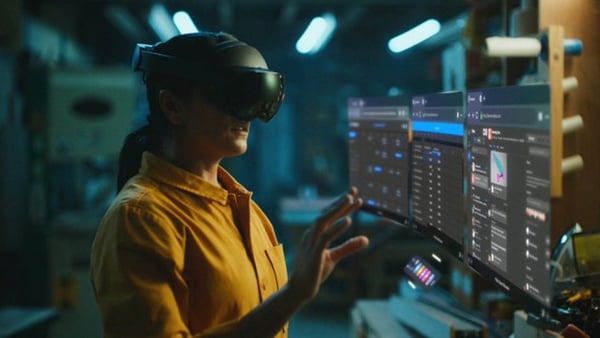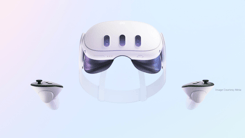When brands like Apple and Microsoft have massive followings and are used across a variety of industries, fans may feel the tug to go out and get the newest version of their devices as soon as they are announced. With the newest headset from Meta, the Meta Quest Pro, many VR fans probably feel the same way. However, this device has changed its main audience, skewing away from the home user and aiming directly at working professionals who use VR in their workplace.
Many architects have already incorporated VR into their firm’s workflow and have been using Meta’s VR Headsets for some years now to facilitate their VR experiences with clients and colleagues. With the release of the Quest Pro, we want to lay out the difference between the Meta Quest vs Quest Pro and then offer our thoughts on which device is best for use in an architectural environment.
What sets the Meta Quest Pro apart from its predecessors?
This time around, the changes are much more drastic than those we saw between the Meta Quest 1 and Meta Quest 2. There is a whole new suite of features and new hardware added to the headset that focuses on expanding not just the VR capabilities of the headset, but also the AR capabilities. Making this one of the biggest mixed reality or XR devices currently available. See a breakdown of these features below.
AR equal to VR
Let's start with the big feature that’s been heavily advertised by Meta. The Meta Quest Pro has brand-new AR features that are designed to really take the device into the XR space. There has been major improvements on the pass-through feature that was first introduced in the Quest Line to facilitate more AR experiences. The previous passthrough was simply in black and white and was used as a way to let you set a safety zone and make sure you weren't wandering into potentially dangerous parts of your surroundings. This time, instead of it being just a safety feature, it's one of the main features of the headset. By making it fully in color and adding brand-new tracking capabilities that allow you to project AR into the space around you, the Quest Pro has made this a key feature.

An example of the AR Capabilities of the Meta Quest Pro (Image Courtesy: Meta)
With this new feature, we've seem people taking advantage of the tech by projecting external monitors into the space around them, manipulating detailed 3D models designed in CAD in the space around them. AR is becoming more popular and used across a lot of different industries and to have a device truly dedicated to it, could be an excellent tool. The Meta Quest Pro also increased the potential collaboration capabilities of AR as well. If multiple people were wearing the Quest Pro, they could actually see the same AR object and manipulate it in the same ways, rather than having to rely on looking at a single screen of a mobile device, for example.
This is definitely one of the most exciting features of this headset. We are very excited to see where Meta can take this technology.
New Hardware for social connections
Full-color AR pass-through isn't the only brand-new feature that's been added to the device. Meta has also added several tracking tools that are supposed to help facilitate more authentic social experiences in VR spaces. In the previous Meta quest lines, hand tracking was introduced later on, which allowed people to manipulate things in VR software without the use of controllers. Meta has upped the ante this time by introducing lip tracking and eye tracking.
The main way these features are being used is within some of the social experiences that meta has been creating for their devices. With programs such as Horizon Worlds, people are able to meet up in VR spaces and have a conversation as they would in an office through the use of virtual avatars. By adding eye and lip tracking, the goal is to animate these virtual avatars using this tracking data to make it look like they're actually saying the words and looking at them as they would be in real life. The aim is to fully replicate the data we get from people via body language and expression. Meta is working to make the virtual meta space more of a social experience and more human, rather than feeling so lifeless and virtual.
The technology that they've included here is also being developed in other headsets, specifically eye tracking. A lot of gaming headsets are using this eye-tracking technology to make sure that they are only using the power to render what the users are actually looking at within the headset. That way they can lessen the rendering power used on parts of the virtual environment that aren't actively being viewed. Would be interesting to see how media takes advantage of these trackers and how they might implement them into other pieces of software.
A new price for new features
Obviously, with all these new features and hardware there is going to be a change to the headset price. The original Meta Quest line has often been touted, including by us, as one of the more affordable pieces of VR technology available to consumers. $400 as an entry point into getting some, truly stunning VR experiences is a very low barrier for a lot of people. It definitely made it much easier to consider adding VR to someone's business as the investment would be low and risk would also be low.
The Meta Quest Pro, however, since it is being aimed at professionals, is coming with a bit of a professional price tag as well. Meta has said that they want this to be a device that can replace someone's work computer or laptop, and so with that comes a similar price to those pieces of technology. At this moment, you can currently get the Meta Quest Pro in the US for around $1500. This is a step up from the previous devices and it's going to be a larger barrier for people to consider.
Meta for Architects: Quest vs Quest Pro
So now we come to the part where we're going to talk about which device we would recommend to architecture firms. It does depend on where you are currently at with VR use in your architecture firm. Is VR a tool that you use for collaboration between your own colleagues? Do you just use it for presentations to clients? Is it a tool that your workers will use remotely, or is it something that's going to be used strictly in the office? These are all things that have to consider when deciding the device that you want to use within your practice.

At Yulio, our recommendation still is the Meta Quest 2. We find that most architecture firms use VR as a presentation tool for projects, and pop in and out of the experience during meetings. They may reference VR when building their projects to see how things are looking or how their design is coming along, but they aren't really working with others within their virtual space in a way that requires the social elements of the Pro. Because of that, a lot of the social tools and AR tools that are included in the Meta quest Pro probably won't be actively used within an architecture firm. When it comes to the presentation side of things, the Meta Quest Pro experience is going to be very similar to the ones offered within Meta Quest 1 and 2. The biggest difference is that the field of view in the Meta quest Pro is slightly larger, but otherwise, the viewing experience probably isn’t worth the price bump alone.
However, if you are an architecture firm that has fully embraced the Metaverse and is taking advantage of a lot of different remote tools, and has its workers working within virtual spaces. Then yes, the quest Pro probably is worth it for your firm. However, this is the first XR device from Meta. Like with many first-generation products, you may want to wait for a generation to see if they can iron out any issues and give a chance for more software to be developed for the tech.
Bottom Line
The Meta Quest Pro does introduce a suite of new features that are interesting and take advantage of some of the latest technology. However, because of these new features and hardware, the price of the headset is much greater than previous devices from Meta. That price is too large of a barrier for us to recommend to most architecture firms who may simply want a VR device that they can use to present their designs and ideas to clients and probably won't take advantage of some of the new AR tracking tools added to the headset. Of course, headsets are the final step, so find out more about getting the content to present on your quest device here.
Check out more about the release of the Meta Quest Pro and our deep dive on more of its features. Also, take a chance to look at our guide and how you can incorporate VR into your workplace workflow.






